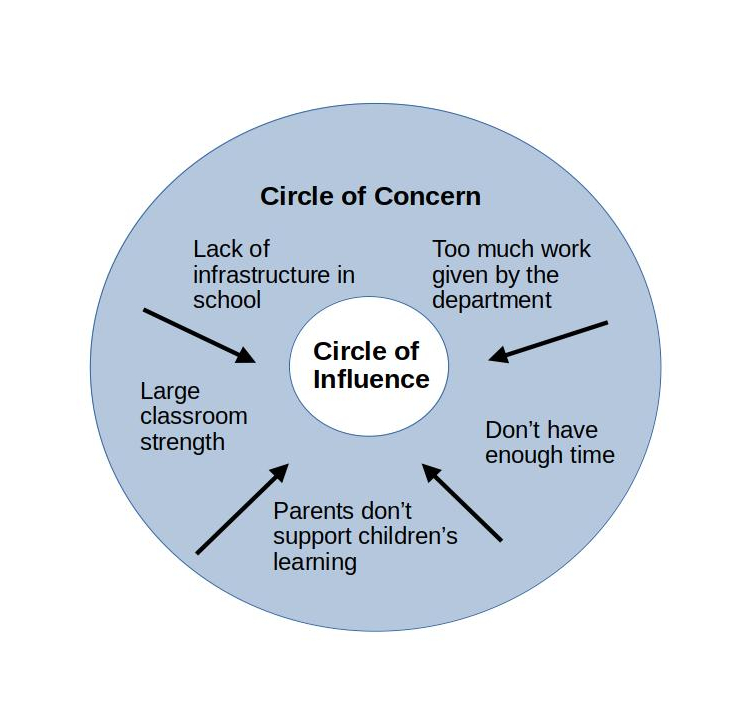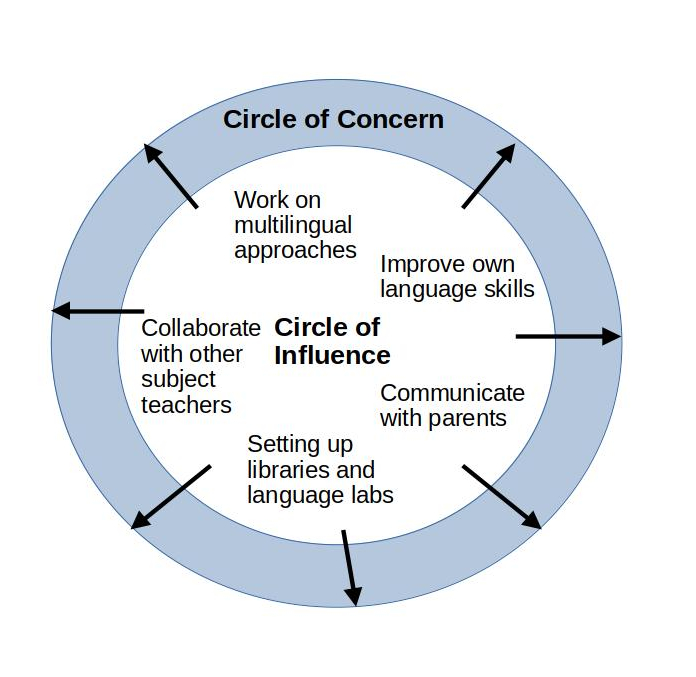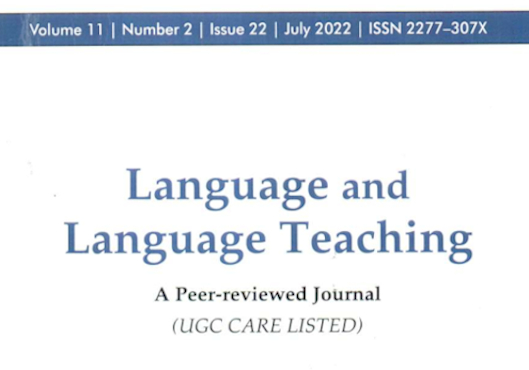Abstract : English language teachers articulate several reasons for their students not achieving competence in English communication. The socio-economic context of the learner, including the home environment, does not provide opportunities for English / second language acquisition (SLA). The compulsions of the syllabus, examinations being entirely in the ‘written’ mode, and lack of support from colleagues result in a non-conducive school environment for SLA. Stephen Covey's framework of the 'Circle of Influence (COI) and the 'Circle of Concern' (COC) suggests that the teacher’s initial focus should be on factors that are within her COI. Stephen Krashen's hypotheses provide specific suggestions pertinent to the COI of a teacher, that can support SLA. Primarily these pertain to pedagogical choices in the classroom and school. In addition, a teacher can engage, negotiate, and network with other actors in the school system to impact larger factors within her COC, enhancing her agency.
Keywords: Teacher Agency, English Language Teaching, Krashen’s Hypotheses, Circle of Influence, Circle of Concern.
This article was carried in the August 2022 issue of the Language and Language Teaching journal of Vidya Bhawan Society.
Challenges to ELT
Several state governments have opened English medium schools1 (Telegraph India, 2020), conceding to parents' strong desire that their children gain competency in English. Among the 41 languages available in the curriculum, English is the only language taught in all Indian states as a first, second, or third language and is taught in the largest number of schools (Annamalai, 2004). Nevertheless, ELT in India, especially in government schools, comes with many challenges, and most students do not acquire adequate communicative skills in English.
IT for Change, a Bengaluru-based NGO, designed and conducted online sessions on English language teaching (ELT) for 1,235 teachers from government-run primary and high schools in South India and Odisha in association with the Regional Institute of English, South India (RIESI)2 during the pandemic (academic years 2020-21 and 2021-22). The sessions began with a group discussion on the challenges faced in ELT (Desai and Rakesh, 2021). The qualitative responses were documented online in a digital mind-map. Issues raised included the socio-economic background of the learner, unsupportive home environments, inadequate and rigid school environments, pressures to 'cover' the syllabus within the academic year, etc. Their coded and categorised articulations are briefly discussed below.
Learner context
Students are shy and lack confidence to speak in English. They are also afraid to speak in English, fearing ridicule by classmates and punishment from teachers for their mistakes. Fear, lack of basic language competencies even in their native language, and inferiority complex from studying in mediums of instruction other than English are barriers to acquiring English-language competency. Consequently, they are not motivated to learn the language. Also, English has a structure different from other Indian languages and hence is difficult to learn.
Home and community
Teachers shared that students mostly come from socio-economically marginalised sections or are first-generation school-goers. Parents cannot afford to buy books and other learning materials for their children. Hence, the home does not provide support for English. Teachers felt that the strong influence of the students' native language interferes with their ability to understand and pronounce English words. Children prefer to respond to questions in their native language, and they understand better when concepts are explained in it.
School environment
A student-teacher ratio exceeding 50:1, common in Indian high schools, is a pedagogical challenge. This makes it challenging to adopt various activities, and individually attend to students. The English textbook and the English teacher are usually the only resources students have for learning English. Even in so-called 'English-medium' schools, other subject teachers do not speak or teach in English since it is not compulsory. With the over-use of local languages in the classroom, students lack vocabulary and fluency in English. There is pressure from the school management and the school system to complete the syllabus; teachers find all their time exhausted in teaching the textbook, leaving no time for other activities. Thus, English teachers get little support from their school management or other teachers to create a conducive environment for ELT.
Syllabus and assessment
Teachers shared that the syllabus does not meet learners' needs. Having the same textbook and written summative examination for all, irrespective of the context and level of the learner, makes ELT like a ‘procrustean bed’ where exact conformity is expected of all students. Another challenge was the insufficient time (each period is usually only 40 minutes) to engage in participatory activities. The extensive syllabi and the rigid assessment pattern set by the administration require teachers to have much more time and resources, which are unavailable.
Circle of Influence (COI) and Circle of Concern (COC)
It is difficult for a teacher to modify learners' contexts, or the syllabus and assessment processes. Therefore, many teachers feel that they cannot fully support their students in acquiring English. Here, the Circle of Concern (COC) (Figure 1a) and the Circle of Influence (COI) (Figure 1b) framework popularised by Stephen Covey (1989) can suggest some possibilities for action. COC suggests that there would be variables of concern to an individual, that affect their motivations, activities, performance, achievements; ranging from personal health, relationships, financial situation, national and global issues like the macro-political situation, climate change etc.
The COI consists of factors under the control or influence of the individual. Though the teacher is undoubtedly subject to many factors beyond her control (discussed above), she usually does have a fair amount of influence over the teaching-learning processes in her classroom, which constitute her COI. Here, the hypotheses for second-language acquisition (SLA), framed by linguist Stephen Krashen (1987,1988), suggest some possibilities on how a teacher's pedagogy can influence SLA.

Covey (1989) suggests that people who focus mainly on external forces outside their control tend to blame their circumstances and feel helpless and frustrated. Such an approach could also result in their COI shrinking because it becomes difficult to recognise factors they can influence. People who are self-aware and focus on their COI may see it expand to cover a larger part of their COC due to enhanced abilities and confidence.
Krashen's hypotheses
Understanding and applying the acquisition-learning, input, and affective filter hypothesis proposed by Krashen (1987) can enable teachers to support SLA. The acquisition-learning hypothesis distinguishes 'acquiring' and 'learning' a language and suggests that acquisition (which describes the processes supporting first language acquisition at home) should come first, even in SLA. The input hypothesis advocates for the supply of a 'comprehensible input', containing messages that students want to hear and can understand without much difficulty. Teachers must provide a high volume of input in English, which learners can understand. The affective filter hypothesis suggests that low anxiety, high motivation, and self-confidence among learners reduce the hindrances to their SLA. Teachers need to create a stress-free environment in classrooms so that students can participate and speak without fear. Teachers punishing learners for their mistakes, and peers ridiculing them, increase the affective filter and must be avoided entirely.
Krashen's hypotheses allow a teacher to explore and experiment with pedagogical approaches and methods in the classroom to support SLA. Teachers exercising their COI can thus offset the challenges of the COC to some extent.
Exploring Krashen's Hypotheses in Government High Schools
Pedagogical practices derived from Krashen's hypotheses were attempted in the 'Teachers Communities of Learning' program in government high schools (Krashen’s Hypotheses, 2021). Teachers were encouraged to use and adapt these to "promote the levels of creativity and fluency and accuracy that a child so effortlessly displays at a very young age without any formal intervention" (Agnihotri, 2010, page 6) . The suggested activities include peer-reading, group-reading, peer or group storytelling and conversations on events; providing additional audio inputs for the child to listen to English in different ways; and encouraging participation and interaction. Students created stories based on their experiences and interactions in 'Digital Storytelling' projects, using audio, video, pictures, and text. This helped them overcome inhibitions and develop a desire to learn the language while fostering the willingness to work together (Ranganathan and Kasinathan, 2017). We have not seen dramatic changes in students' abilities to speak or write English over a semester. However, their eagerness to engage with classroom activities and complete their home assignments increased noticeably.
| Traditional Pedagogy | Pedagogy for SLA (Krashen's hypotheses) |
|---|---|
| Learning – focus on the structure of language (Grammar) | Acquisition – focus on meaningful communication and not on the structure of language. Focus on fluency. |
|
Reliance on textbooks, minimal language spoken to the learner. English spoken from a textbook may not be fully comprehensible. The translation approach may reduce opportunities for listening to English. |
Immersion of learner in language through a high degree of listening exposure to the language. Teachers mostly speak in comprehensible English, although the learners are free to express themselves in the language of their choice. |
| Pressure on learners to produce language, both speaking and writing. | No pressure on learners to produce language; they produce when they are ready. |
| Focus on accuracy, regular assessments, correction of mistakes, and peer ridicule, which create a stressful learning environment. | Fluency is more important than accuracy. Focus on creating a stress-free environment by accepting learners’ mistakes and encouraging individual and group participation. |
Expanding the COI to address COC
Focusing on COI enables teachers to move beyond feeling helpless and a victim of circumstances. However, neither COI nor COC need to be fixed or static. While the teacher can continue working with factors that are within her COI, there are ways by which she can work with the COC variables and attempt to bring them within her COI. Teachers offered examples of such work involving engaging, negotiating, and networking with other actors in the education system. These discussions and practices from the 'Teachers Communities of Learning' program are discussed below (also see Figure 1b) as a way to expand the COI, enhancing teacher agency.

Working to create a conducive school environment for SLA
A conducive learning school environment is critical for students to flourish. Teachers can set up reading corners in their classrooms, libraries, and language laboratories and work with other language teachers to create a rich, multilingual environment. The library can also have audio resources, which the teacher can create or adapt from available open audio educational resources3. Students can listen to stories and read them simultaneously.
A usual 40-minute period may be inadequate for participatory activities. To remedy this, English teachers can request other teachers to adjust their timetables to create a 'block period' of 80 minutes. Teachers can work with the school administration to organise events like language 'melas' (festivals) to create awareness and provide a platform for students to participate and learn. They can encourage students to participate in 'show and tell' activities, produce English magazines, and organise exhibitions of student creations. English teachers can work with other language and subject teachers to explore multilingual approaches in subject teaching so that the learners listen to meaningful input in English over the day, not only during the English period. According to Parashar (2012, page 1), "We must take steps to produce methods and materials designed to help students coming from tribal, rural, and other neglected sections of society who, though gifted and intelligent, feel alienated and handicapped". Teachers can create local/contextual materials in their subjects that promote multi-level and multilingual learning, which would support SLA.
Communicating with parents
Teachers can create awareness among parents about their role in their children's learning and language development. The awareness can influence parents to encourage interactions that support language acquisition at home. Teachers can communicate with parents using technologies like phone groups and voice broadcasts. They can also encourage parents to allow children to watch English TV channels, listen to radio programs (or web podcasts), buy storybooks and, where possible, speak to children in English at home.
Networking with teachers through learning communities
Teachers can network with other teachers to create professional learning communities where challenges, best practices, and resources are shared. They can also work (through their learning communities/unions) with the education department to allow them a freer hand in using Teaching Learning Materials (TLMs). If given a certain degree of autonomy to design assessments without restricting themselves to the prescribed textbooks and syllabus, teachers will likely consider catering to the diverse needs of their students.
By actively engaging, negotiating, and networking with other actors in the education system, teachers can expand their COI to cover more of their COC. It is likely that this process will further expand their COC, and make them want to engage with larger issues in education. Thus, strengthening teachers' agency through conscious and voluntary acts of expanding their COI and COC, can support teachers' professional development and bring them into the efforts to address larger challenges in education.
Conclusion
We see that challenges in ELT are complex and often difficult to resolve. Issues of assessments, syllabus, infrastructure, and the learners' background are deep-rooted systemic factors that are not easy to change quickly. Though within their COC, these challenges are beyond the COI of teachers. Rather than only focusing on COC factors, teachers can identify the possibilities within their COI and work towards addressing them. Furthermore, they can attempt to widen and expand their COI by engaging, negotiating, and networking with other actors in their contexts. The network includes their peers in the school, school management, parents and parent bodies, and the education administration system. This would inspire and enthuse other teachers, highlighting their ability to build their capacities and claim, exercise, and enhance their agency.
References
Agnihotri, R. K. (2010). Multilinguality and the teaching of English in India. EFL Journal, 1(1), 1-14.
Annamalai, E. (2004). Medium of power: The question of English in education in India. In J.W. Tollefson & A.B.M. Tsui (Eds.), Medium of Instruction Policies: Which Agenda? Whose Agenda? (pp. 177-194). Lawrence Erlbaum.
Covey, S. R. (1989). The 7 Habits of Highly Effective People: Powerful Lessons in Personal Change. Simon & Schuster.
Creating Audio Open Educational Resources. (2020, September). Open Educational Resources. Retrieved February 15, 2022, from https://teacher-network.in/OER/index.php/Audio_OER_creation_course_for_RIESI_CELT,_September_2020
Desai, A., & Rakesh B. (2021, November). Supporting ELT During the Pandemic: Experiences with Teacher Education. Bengaluru; IT for Change.
https://itforchange.net/sites/default/files/2004/Supporting-ELT-during-the-pandemic-Experience-with-Teacher-Education.pdf
Jeyaraj, J. (2016). ELT in India: An Analysis of Pedagogic Fallacies. SSRN Electronic Journal. 3. 1-8. 10.2139/ssrn.3486448.
Jeyaraj, J. (2017). Challenges of Teaching English in India. SSRN Electronic Journal. 10.2139/ssrn.3486395.
Kasinathan, G. (2019, July). Teachers' Community of Learning (TCOL) in Government Aided High Schools (2018-21). IT for Change. Retrieved February 15, 2022 from https://itforchange.net/index.php/teachers-community-of-learning-tcol-government-aided-high-schools-2018-21
Krashen, S. D. (1987). Principles and Practice in Second Language Acquisition. Prentice-Hall International.
Krashen, S. D. (1988). Second Language Acquisition and Second Language Learning. Prentice-Hall International.
Krashen’s Hypotheses. (2021, July 31). Open Educational Resources. Retrieved February 15, 2022, from https://teacher-network.in/OER/index.php/Krashen_hypotheses
Parashar, A. (2012). English Language Pedagogy: Some Issues in Teaching and Learning. The Indian Review of World Literature in English, 8(I), 1-6. https://worldlitonline.net/english-language-archana.pdf
NCERT. (2006). Position paper: National focus group on teaching of English. (pp. 1-5).
Ranganathan. S. and Kasinathan (2017, August). Digital storytelling: an ICT-based method of co-constructing and transacting curriculum. https://ncert.nic.in/pdf/publication/journalsandperiodicals/vtte/vtte_aug_2017.pdf
Telegraph India. (2020, July 26). First choice: 'english' education. Rising demand for English as the medium of instruction in schools - Telegraph India. https://www.telegraphindia.com/opinion/rising-demand-for-english-as-the-medium-of-instruction-in-schools/cid/1787454
Notes
1. A simple web search for “Indian governments opening English medium schools” will throw up many state government announcements.
2. As a part of the Certificate in ELT (CELT) course offered by RIESI, IT for Change designed and conducted sessions on Krashen’s Hypotheses for Second Language Acquisition, and audio resource creation, for government primary and high schools English teachers from the states and union territories in South India. ITfC works with government schoolteachers in Bengaluru, through the ‘Teachers Communities of Learning’ program.
3. We introduce teachers to audio stories from ‘Karadi tales’ and conduct capacity-building sessions to enable them to create audio resources using ‘Audacity’, a free and open-source software.
About the authors
Marzia Ibrahim works on developing the technology and language teaching-learning programs at IT for Change. She has previously worked as an English language teacher and facilitator in private and government schools. Her interests lie in the curriculum and pedagogy of languages, especially in multilingual contexts. marzia_at_itforchange_dot_net
Anand Desai is Education Program Manager with IT for Change. His work focuses on the meaningful appropriation of digital technologies for social change. It reflects his interest in a multilingual approach to language learning and resource and activity-rich learning environments in the classroom and beyond. anand.desai_at_itforchange_dot_net
Gurumurthy K is Founder and Director of IT for Change, Bangalore. His areas of expertise include ICT integration in school education, and education leadership and management. He works in the areas of pre-service and in-service teacher education, policy advocacy, and digital society. Guru_at_ITforChange_dot_net

